
Hearing stories about refugees allows children to learn about the reasons why people make the agonising choice to flee their countries and put themselves in life threatening situations in a desperate attempt to seek safety. These stories are gateways to important conversations, they have the power to dismantle bias and encourage empathy and inclusiveness.
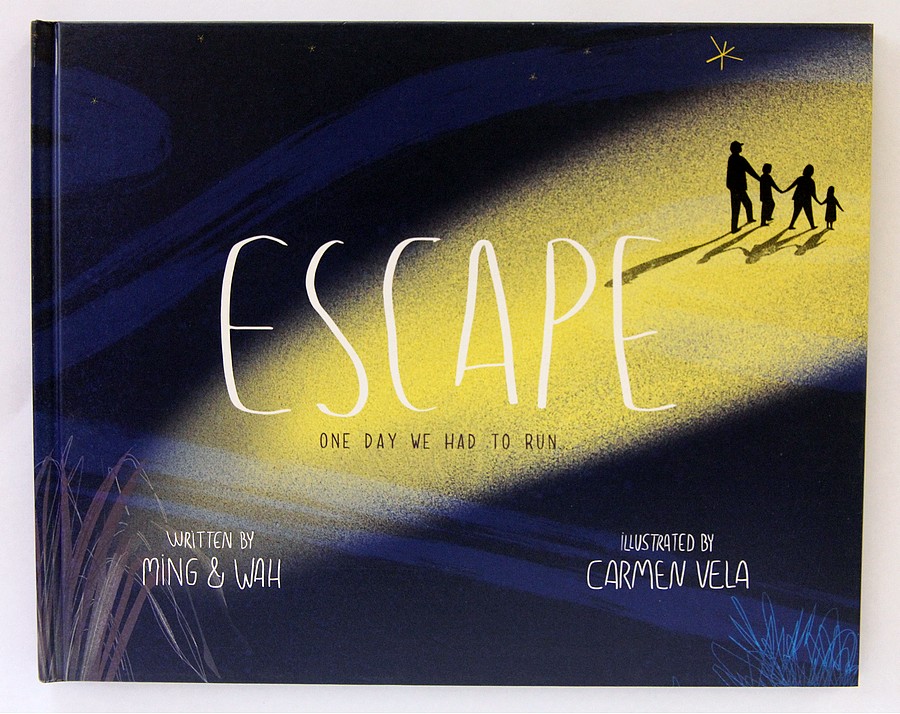
Escape: One Day We Had To Run is a picture book by Ming and Wah and illustrated by Carmen Vela. This is a powerful collection of twelve true stories of courage and tenacity in harrowing circumstances. These are stories about desperate people fleeing their homes because of war, famine, slavery, intolerance, economic and political upheaval and there is also a story about the first legal climate change refugee. These stories contain extraordinary displays of human strength, of the mind and body, in life threatening situations, where people are driven by sheer desperation to push themselves to defy the odds. The title page says: “ES-CAPE (verb) To avoid threatening evil”. The following page lists twelve action verbs, such as cling, defy, pedal, swim and tunnel which are key to a story of escape and the tremendous obstacles that are overcome in the quest for safety. At the beginning of the book there is also a world map which shows the route for each of the journeys. The final page shows Articles 13 and 14 from The Universal Declaration of Human Rights. Each arresting story is featured on a double page spread and features the verb and its definition, a paragraph recounting the story of escape and an illustration which adds another layer to the compelling text. A full review for this book can be found on the Reading Opens Doors blog here

Home by Karen Hendriks and illustrated by Alisa Knatko is a moving fictional story that highlights the human face of loss and displacement. This story has been inspired by the author, Karen Hendriks’ family heritage. The reader learns in the notes at the end of the book that this is the story of the largest forced refugee movement of a single population in the twentieth century, as Karen writes, “between 1945 and 1946, three million Sudeten Germans were expelled from the Sudeten Mountains to Germany, Austria and the Soviet Union. ..This story is inspired by the village of Wunshendorf, now called Srbska, and a part of Czechoslovakia.
The story begins in a peaceful, snowy village that looks serene and inviting. This tranquil scene is abruptly changed once soldiers arrive and order the people to leave. This story centres on a family consisting of a Mama, Papa and young girl who flee their family home with very little. They board a train. The young girl has one item in her possession that the guards do not take, a silver locket that she treasures and it comforts her. It contains the memories of her home and she cradles it when she is scared and confused. Her heart feels the locket whisper words of encouragement which give her strength and guidance. The story explores the journey of this family and others who were forced from the village. They lived for part of their journey with other displaced people in a camp in the depths of a forest, away from any evidence of civilisation where they foraged for food to survive. Even though their circumstances are tragic, this story highlights the ways in which these people overcame adversity and even managed to find slices of happiness, for example, when they connected with each other and huddled together to sing their songs from home or performed their village dances.
The text which contains vivid descriptions and figurative language, together with the evocative illustrations elicit such a moving reaction to this powerful story. Alisa Knatko uses different colour palettes to make the story come alive and separate the different times – grey tones for the parts of the journey where the people are fleeing, adding to the sense of foreboding and fear. Colour is used for the story about the people, their story is one of hope, love, courage, resilience and the power these have when all seems lost. The vivid images offer a hint of the feelings of loss, despair and trauma experienced. This book offers a plethora of opportunities to study visual literacy elements, for example, analyse the body language such as facial expressions, stance as well as how people’s eyelids are lowered to show despair; examine the different angles employed to convey points of view from different characters. At the back of this book is further information about this refugee movement and a touching note to Karen’s Mum and Oma.
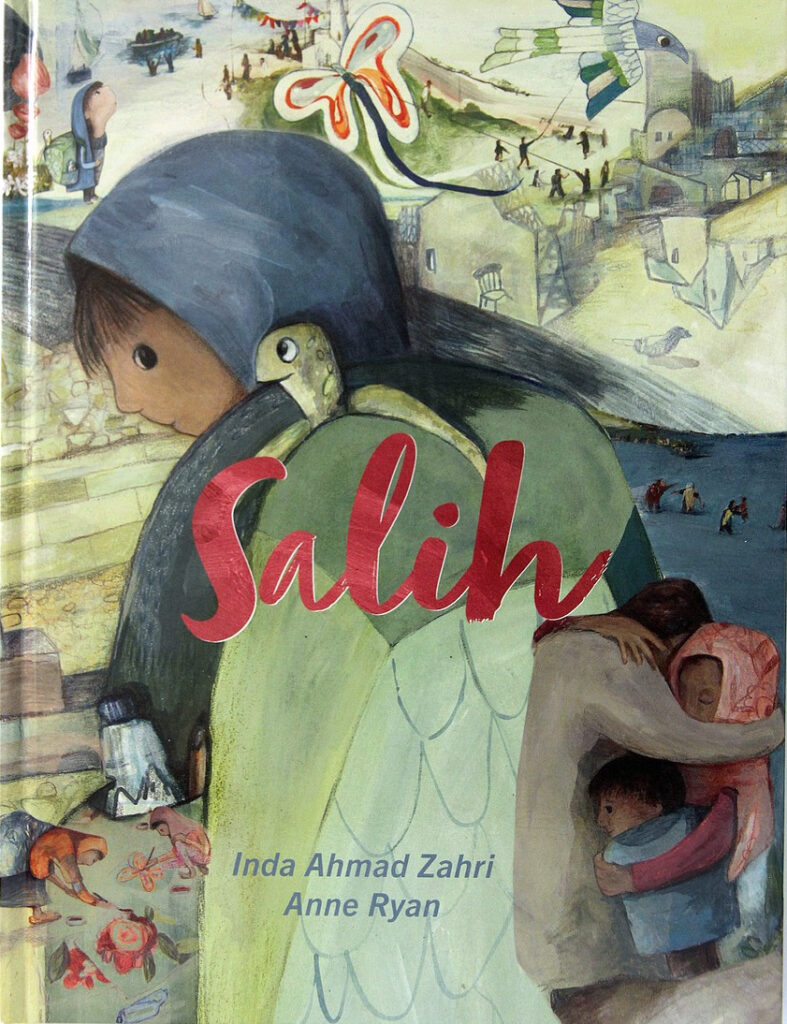
Salih by Inda Ahmad Zahri and illustrated by Anne Ryan is a refugee story of courage, hope and kindness. It centres around the character of Salih, a young boy who carries his home on his back, similar to that of a turtle, because he and his family, together with many other people have fled their war-torn homes in search of a safe haven. They have left behind all that is familiar; family, friends and taken with them their memories. These memories include joyful times, cosy rituals and an inspiring teacher who has touched their lives. Happy memories that are relatable, experiences readers will be able to identify with and likely share with Salih. Nestled together with these positive, comforting recollections are the dark, frightening times that include deafening blasts, signs of devastation and people suffering.
In a refugee camp, Salih meets a painter and together with other refugees he finds comfort in painting precious memories. These are bright pictures of hope and Salih rolls the artworks up and places them in bottles which he carries with him on a perilous journey across a raging ocean to a new home. After a terrifying voyage and much pleading with the sea to be calm, the ocean eventually quietens and the refugees arrive in a new land…a place that received the most unexpected gifts from the ocean. These gifts positively impact the arrival of the refugees and in turn this has a positive ripple effect on the community.
The mesmerising, immersive illustrations with nuance are full of exquisite details and emotion that illuminate the text. This book beautifully highlights the human face of refugees and enables the reader to connect with Salih. As the story unfolds the reader learns snippets of information about several refugees and their individual stories, this informs the reader about their joys, hopes, passions, fears and trials which helps build a connection, as common ground can be identified. This book explores in a nondidactic, sensitive way that all humans, regardless of their circumstances, share feelings of joy, loss and possess a deep desire to have the opportunity to live without fear and be accepted.
On Inda Ahmad Zahri’s website she has a Refugee Week Video Project which contains a series of videos where she chats with her friends about their refugees experiences. Inda shares information about the plight of refugees and discusses ways people can help. Inda also shares picture book readings in this series (some of which have been reviewed in this post). This video series can be accessed here.
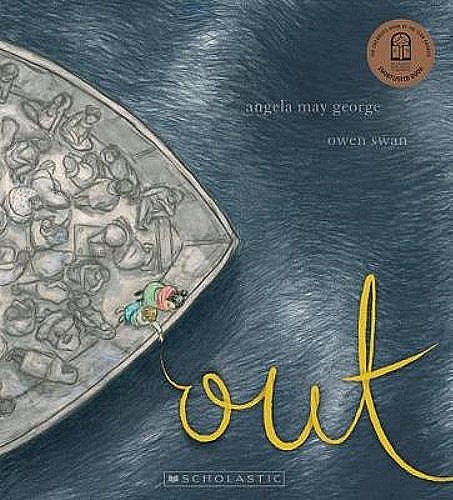
Out by Angela May George and illustrated by Owen Swann shares the journey of a mother and daughter fleeing their country to seek asylum and this story is told from the viewpoint of the young girl. With no other choice, they make the agonising decision to leave their war-torn land and embark on a journey fraught with danger and the real possibility they may pay the ultimate price, their lives. The story shares how they hide from soldiers in a bush setting before embarking on a very long, arduous journey on a boat that feels like an eternity and eventually arrive in a new country. The story then explores their lives after they have arrive, the obstacles that arise and they overcome, the lessons to learn and how their thoughts constantly turn to their home as they both wonder what has happened to their father/husband who they desperately miss. The story also discusses the joy and freedom they feel as they explore this new land. The illustrations are evocative and visually arresting. This story has wonderful opportunities to explore visual literacy elements – the yellow ribbon on each page, the various angles used, the use of colour and how it changes throughout the book (beginning with muted tones that become more colourful as the story unfolds), how movement is portrayed (in the ocean, the ribbon moving). It is a hope filled story that humanises the refugee experience, fostering empathy for the refugees and ultimately making this story accessible for young readers.
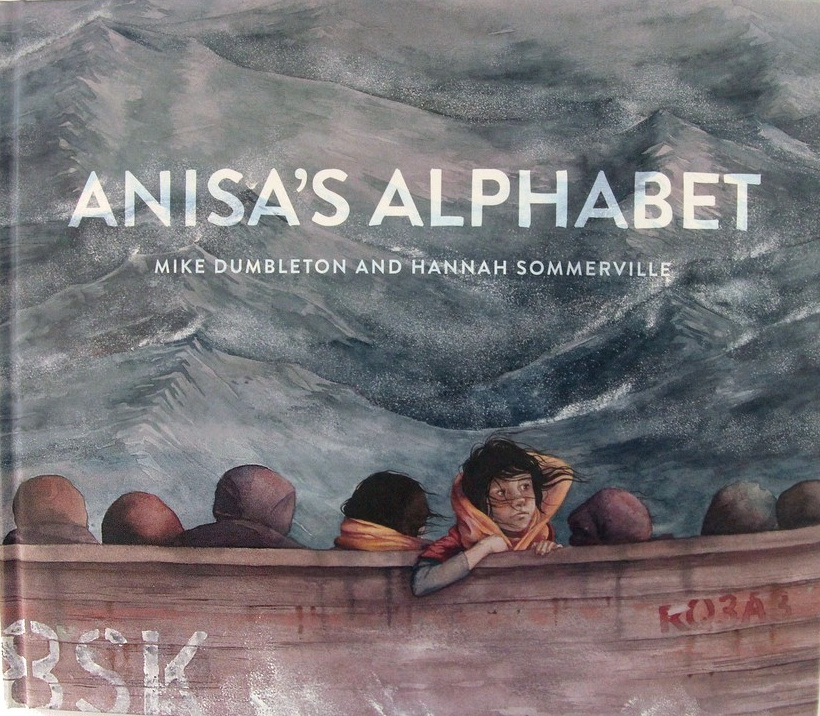
Anisa’s Alphabet by Mike Dumbleton and illustrated by Hannah Sommerville is a picture book told in rhyming text. This book is about Anisa’s moving story of her refugee journey from a war torn county to a new land in the hope for freedom. Each letter of the alphabet is used to reveal another key part of Anisa’s story which is told from her perspective. The illustrations are captivating and reveal so much about Anisa’s experiences, as well as those of her family and other refugees with her. It is interesting to note that the refugees depicted in this book are often illustrated in silhouette form, or outlined with their backs facing the reader in contrast to Anisa and her family who are prominent in the illustrations. The refugees we do not ‘see’ could just as well be the many individual refugees stories that are not heard or told. Hannah’s illustrations in muted tones convey the threatening and often dire situation that Anisa and her family face, while the coloured drawings by Anisa that are included capture her optimism and hope. Even though the themes are difficult and heavy, Mike Dumbleton and Hannah Sommerville have told this story in a way that is accessible for children. This thought provoking picture book will spark many conversations about refugees and their experiences.
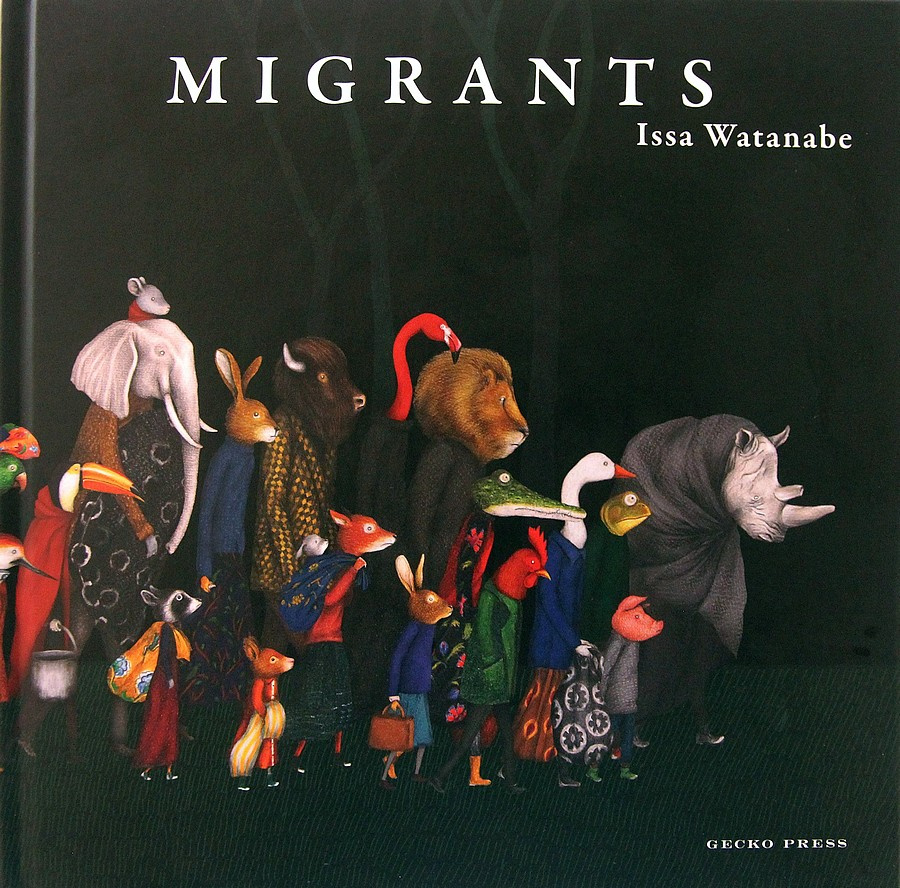
Migrants by Issa Watanabe is a memorable and moving wordless picture book which tells the powerful story of a group of animals who leave their home and embark on a journey filled with dangers and the ever constant lingering fear of the possibility of loss of life. This book follows the animals as they set off on the different stages of their arduous journey – from leaving their home, to setting up a camp, building a boat, setting sail, some surviving and tragically others not and finally arriving in a new place. The powerful images, set against a sombre black background, highlight the fear, fatigue, sadness, uncertainty, perilous and unforgiving conditions as well as the resilience, compassion, empathy and courage a journey to a new land takes. This is a story that demands to be revisited as the evocative imagery, coupled with the many sophisticated details deserve to be savoured – details such as the animals clothing, the unusual combination of animals existing together, the rhinoceros with a broken horn, discovering which animals seemed to survive the journey as well as contemplating each animal’s individual journey (their emotions and actions). While there is much sadness in this story because the migration journey IS a story filled with sadness, it is also a vital story that helps build empathy. This is also a story containing a message of hope (expressed in colour in the illustrations) as the animals connect and share the meagre resources they do have for the common good. They display kindness and resilience through adversity. This is a thought provoking story and gives a voice, heart and soul to people who leave their homes to start anew in a foreign land. The story will inspire many discussions as readers interpret and feel the story. It is a book that will stay with you long after you turn the last page.

Stepping Stones: A Refugee Family’s Journey written by Margriet Ruurs with astonishingly unique artwork by Nizar Ali Badr is a bilingual picture book (written in English and Arabic) about the Syrian refugee crisis and was inspired by the impressive artwork of Syrian artist Nizar Ali Badr who created the artwork with stones he gathered from the beach in Ugarit, an ancient port city in Northern Syria where he resides. This book tells the story of Rama and her family who are forced to flee their once peaceful and much loved home as civil war gripped their country. This book begins with Rama reflecting on her carefree childhood not so long ago, where she and her brother, Sami felt “free as birds”. Rama recalls the freedoms they once enjoyed as well as the hobbies, roles and responsibilities her grandfather, Jedo and parents had. Then war came to her country and a new reality engulfed them. Everything she once knew was gone, food was in scarce supply, people started leaving the village, bombs started falling closer to their home. Rami’s family decided it was time to leave. They “walked to the end of the earth”, “they were walking toward a bright new future”. They then began their treacherous ocean journey which some people did not survive. Their journey continued on land until they safely arrived at their new future, wondering if it will be forever and there they were welcomed by neighbours. Each powerful illustration is expertly created with the positioning of each stone richly adding to the story and creating evocative scenes. At the end of this book is information about the author, her inspiration for this story and information about her collaboration with Nizar Ali Badar. There is also information about Nazir Ali Badr. The final page shares some website links readers may wish to explore to help make a difference.

Nicky and Vera: A Quiet Hero of the Holocaust and the Children He Rescued by Peter Sís is the powerful story of Nicholas (Nicky) Winton who organised for 669 children to safely leave Nazi occupied Czechoslovakia to live with foster families in England. This is a story of one remarkable man seeing a desperate need and responding, despite all of the obstacles in his path; it is a remarkable story about making a difference and it is a story filled with heart, courage and hope.
Nicolas Winton never considered himself a hero, as he believed he did what needed to be done. This act of love carried out with the utmost compassion and without ever expecting anything in return serves as a shining example of how to act when there is a blatant need to be addressed. Nicky’s actions also highlight how to be a voice for those who have been robbed of theirs and to serve through actions in times of need. A full review for this book can be found on the Reading Opens Door blog here
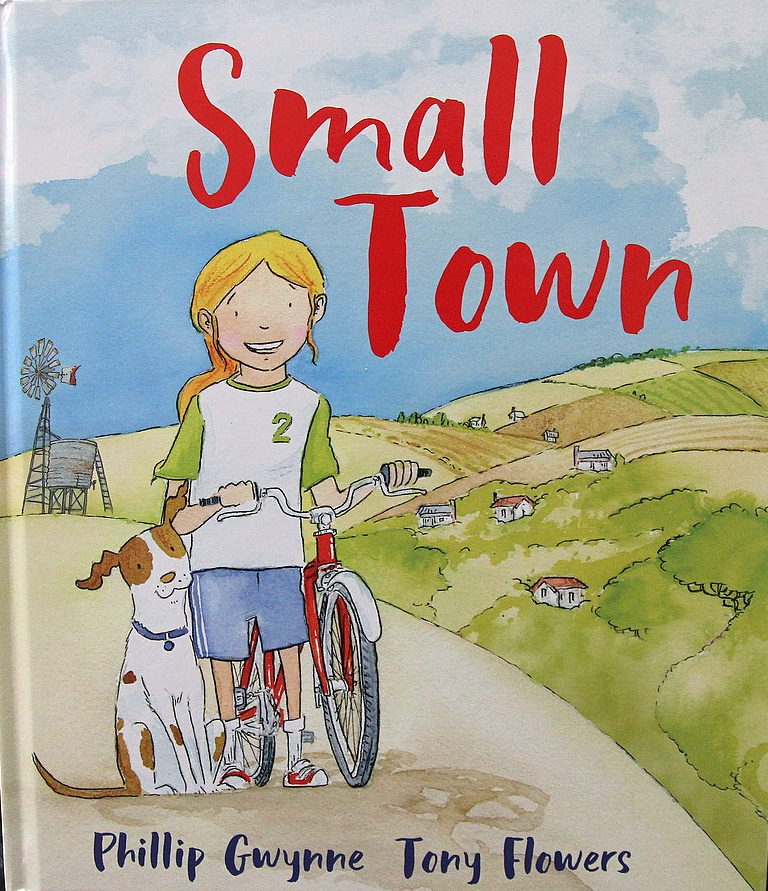
Small Town by Phillip Gwynne and illustrated by Tony Flowers is an uplifting celebration of small rural towns and people power. The narrator of this picture book is Milly, a proud resident of Gong Gong. Milly is troubled by the number of people leaving her town and decides to take action. After learning about refugees at school, Milly decides to write a letter to refugees inviting them to live in Gong Gong and explains some of the benefits of living in her town. Millie’s Granny Mac believes a video would be the perfect addition to her letter, so together they record all of the unique and wonderful opportunities as well as experiences their rural town has to offer. The detailed endpapers are incredible and tell the story about the positive impact refugees can have on a small rural community. The illustrations by Tony Flowers add another layer of warmth to this powerful story. This book explore complex issues such as downturn in regional towns, the pull to the city for employment and opportunities and the impact this has on rural towns, community, activism, grandparents as role models, refugees, the settlement of refugees in Australia and the positive impact they have.
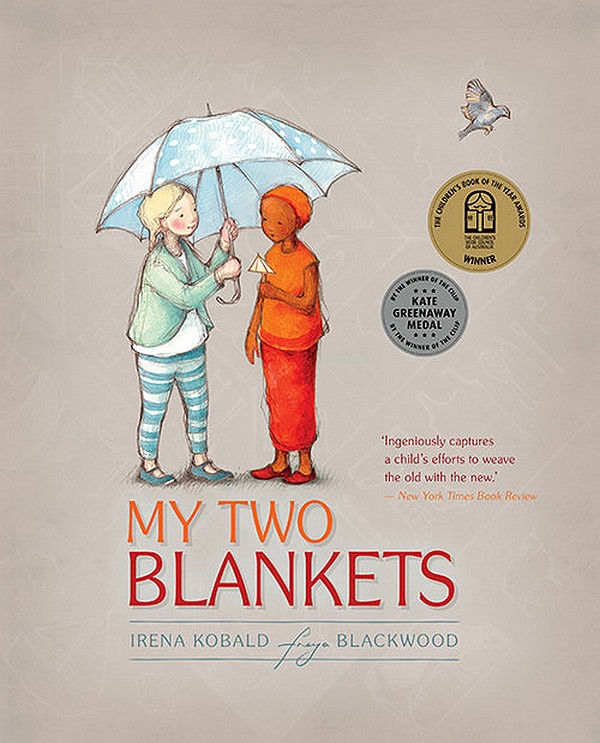
My Two Blankets by Irena Kobald and illustrated by Freya Blackwood shines a spotlight on the foreign feeling and strangeness of being in a new place. This story is told from the perspective of a young girl, Cartwheel, who has recently arrived in a new land with her Aunty and is struggling to adjust to her new world, with new people, a new language, foods, animals and plants, even the wind feels strange. She sees and feels more difference than sameness, resulting in her feeling isolated and alone. She finds comfort in wrapping herself in a metaphorical blanket of her own words, memories and sounds, a blanket that is illustrated using earth tone colours as well as symbols and pictures that remind her of home. This blanket is a metaphor for her home and culture that is familiar and safe to her. While exploring her new home with her Aunty, Cartwheel visits a park. A friendly girl smiles and waves at Cartwheel. While these welcoming gestures are appreciated by Cartwheel and make her feel happy she is unable to interact with the girl because of the language barrier which is also deftly conveyed in the illustrations. When the girls next meet in the park the friendly girl starts teaching Cartwheel new words and continues to do so over several park plays. Cartwheel’s new and expanding vocabulary becomes the beginning threads of a new metaphorical blanket, in predominantly blues and greens and containing pictures of foods, animals, objects and nature from her new home. Cartwheel learns that both blankets are a source of comfort and she now has two stories from two places which are part of her. Be sure to take special note of the final joyful illustration!
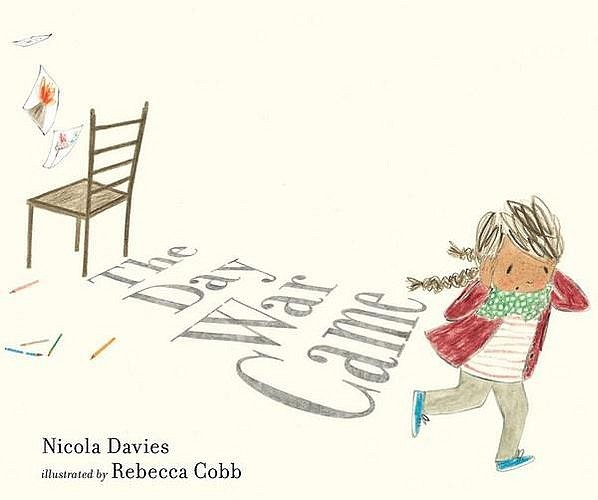
The Day War Came by Nicola Davies and illustrated by Rebecca Cobb is a moving poetic narrative that was written in response to the UK government refusing to give sanctuary to 3000 unaccompanied child refugees in 2016. This is a powerful story that begins with a young girl on an ordinary day enjoying time with her Mum, Dad and baby brother and then going to school. While at school the war came. What follows is a description of what she observed and experienced. The girl then tells of her lonely, harrowing and arduous and journey fleeing the war and arriving in a new country and a refugee camp. She is without her family and has no context to understand what is happening. What follows seems unfathomable as the little girl has doors slammed in her face and a teacher refusing to let her join her classroom as there is no available chair. The girl returns to her hut. While curled up in the hut a boy comes offering a chair and informs the girl that his friends are also with him and they have chairs too. The illustrations have a naivety to them, yet together with the text are so extraordinarily powerful. This story highlights the impact and cost of war through the eyes of an innocent child. This story also shows that tolerance and compassion inspires courageous acts of kindness that are a force for change.
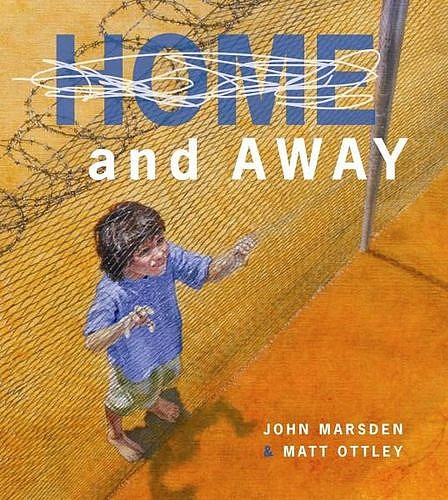
Home And Away by John Marsden and Matt Ottley is a dramatic picture book for older readers – upper primary school and junior secondary school aged children. The pictures in this book really are worth a thousand words – they are powerful, arresting and heartbreaking. This is a story about an Australian family who find themselves in a war and become refugees placed in a detention camp. This story is confronting, but is sure to open the readers mind to the terror, loss, despair and heartache of the journey of refugees.
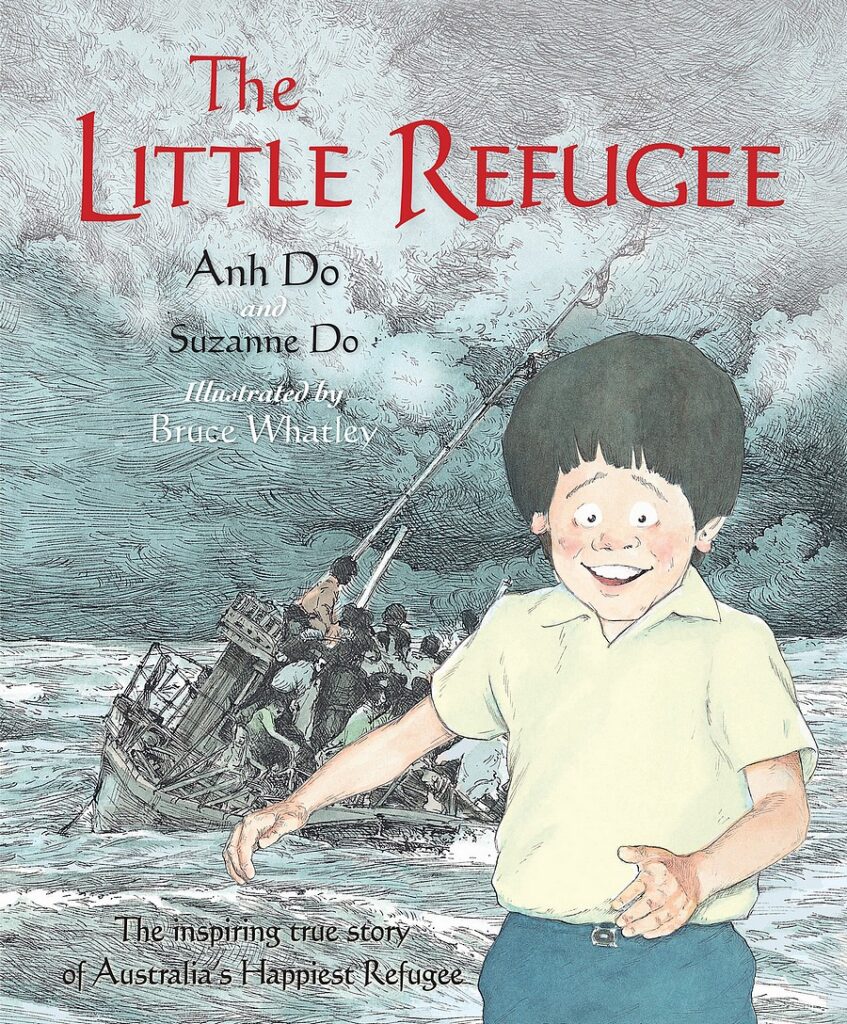
The Little Refugee by Anh Do and Suzanne Do is a powerful picture book inspired by Anh Do’s award-winning memoir, The Happiest Refugee. This story begins in Vietnam, with Anh Do as a happy young boy, enjoying his childhood surrounded by family and love. Oblivious to him as a young boy, his country was involved in a war. After the war, his family were forced to flee their home and country. They fled on board a fishing vessel with other family members, neighbours and friends, forty people in total crossed the ocean on what was a treacherous journey, at times harrowing where they feared for their lives and eventually arrived in the safe haven of Australia. Anh Do’s Mother, despite intense danger, loss and uncertainty never gave up hope. She said to Anh that “you must always have hope that things will be okay”. She saw the positives in hard situations and never took for granted the good that was in their lives. Her resilience, perspective, gratitude for the chance for a better life and strong work ethic were valued and role modelled to And Do and his brother. Anh Do shares some of the struggles his family and him experienced in a foreign country, as well as the triumphs. Despite the heavy themes, this is a story of hope, courage and overcoming adversity. There is so much to gleam and read in the illustrations. There are two contrasting styles of illustrations used by Bruce Whatley – one is more of a contemporary style with cartoon like illustrations. The other style features illustrations that are more photographic like and a sepia colour palette is used, evoking nostalgic feelings to depict what life was like for Anh Do in Vietnam and scenes from the boat trip to Australia.
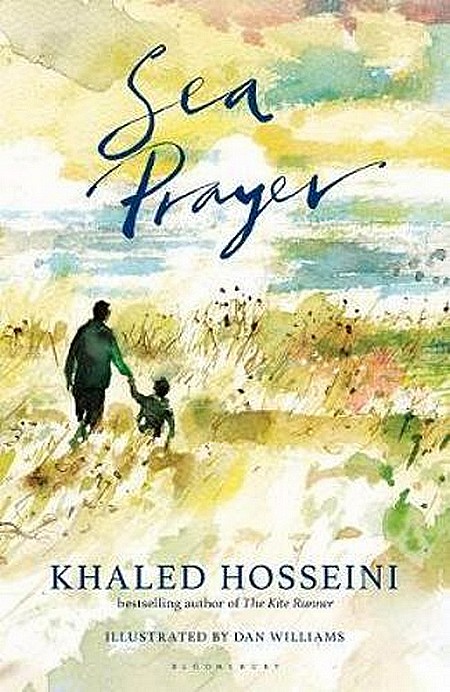
Sea Prayer by Khaled Hosseini and illustrated by Dan Williams is written in the form of a letter from a father to his son and it reads like a poem. It is a powerfully evocative story about refugees who have tragically lost their lives, desperate people who are left with no choice but to leave their homes and travel the dangerous open seas where their lives are at risk in the hope of a better life. Khaleed Hosseini said that he wrote this to bring a human dimension to the plight of refuges and to address some of the misconceptions. This was inspired by the story of Alan Kurdi, a three-year-old Syrian boy who drowned off the coast of Turkey, his lifeless body face down on the shore was photographed and this heart-wrenching photo outraged the world. “In the year after Alan’s death, 4,176 others died or went missing attempting that same journey,” we learn at the end of Sea Prayer.
In this story a father cradles his sleeping son as he shares his blissful, treasured childhood memories with him, a childhood with family in a beautiful area that was his home. A place his son visited as a toddler. He recounts life and the beautiful city of Homs during peace time. He wishes his son knew this place, but tells of his sons lived experiences, haunting tales of bombs, starvation, burials and living in a devastated war zone. The letter then then turns to a prayer, asking for the sea to allow the safe arrival for those traversing the waters. Khaled Hosseini talks about relatable people and experiences, fathers and sons who have a deep love and appreciation for their homeland. Their homes are tied to precious memories. They leave because they must, in order for a chance to live. They embark on journeys filled with dangers, obstacles, life threatening situations and with no guarantees; agonisingly desperate, hoping to find safety and defy the odds.

Lost and Found Cat: The True Story of Kunkush’s Incredible Journey written by Amy Shrodes and Doug Kuntz and illustrated by Sue Cornelison is inspired by the heart warming true story about a family in Mosul, Iraq who fled their war torn home with their cat, Kunkush secretly in tow. Their cat becomes frightened after a dangerous journey and runs away from the family. After a lengthy search, the family has no choice but continue their refugee journey without their beloved cat. The kindness of strangers and a global effort to reunite the family with Kunkush ensues. It is interesting to note that the authors went to Greece to assist with the refugee crisis, their rescue efforts and ways in which they tried to reunite Kunkush with the family are featured in the story. This story highlights the extraordinary lengths fraught with danger this family go to in order to leave their home in search of safety. The family paid smugglers and relied on them to help them leave their country, they embarked on a hazardous ocean journey from Turkey to Greece on a flimsy rubber boat that was designed to carry twenty-five people, however they boarded this boat with over sixty others. This story also highlights the impact of people power and the importance of compassion and kindness.
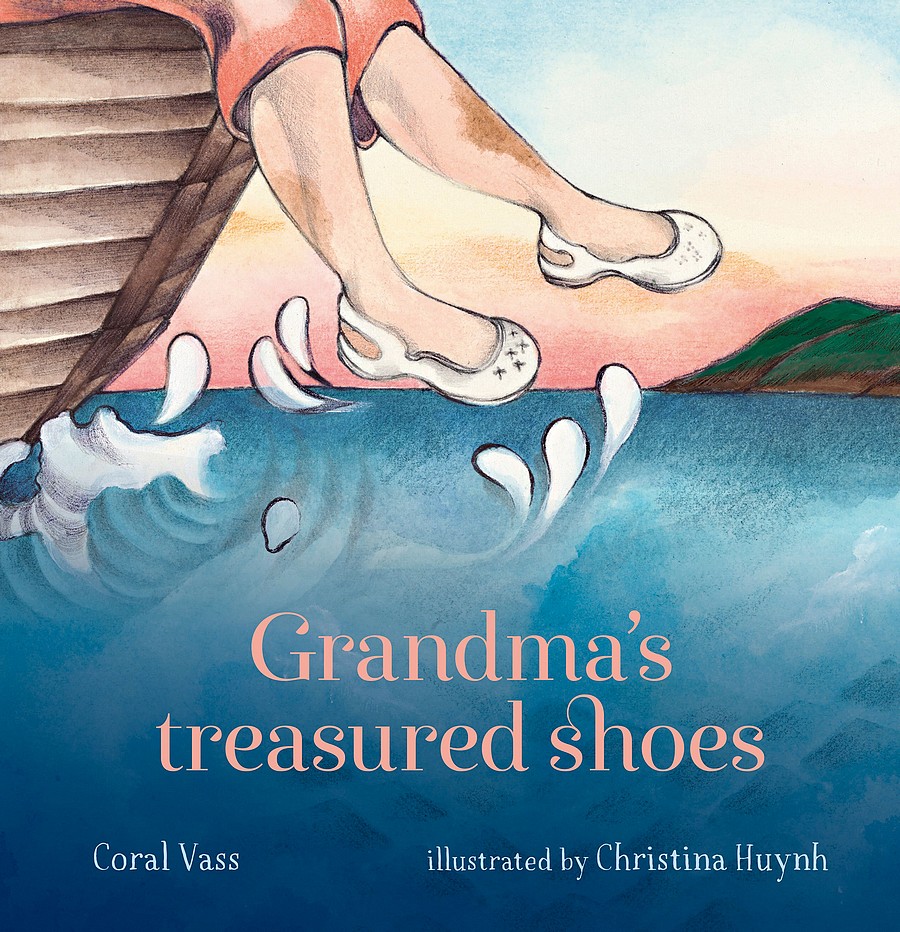
Grandmas Treasured Shoes by Coral Vass and illustrated by Christina Huynh was inspired after Coral Vass saw a photograph of a collection of shoes worn by refugees as well as the quote “walk a mile in someone else’s shoes”. This led her to think about how each pair of shoes represented a journey, each pair represented a story and has a story to tell.
This story begins with Grandma’s eclectic shoe collection such as her walk to the park shoes and her dance in the dark shoes, plus oodles more. But, Grandma has one favourite treasured pair of shoes, they are old and worn and from a time long ago and contain a story filled with remarkable tales. The reader is transported back in time when Grandma was a young girl wearing these treasured shoes and all the memories grandma had wearing these shoes. Grandma’s shoes then write another chapter as they are on her as she flees her home and boards a boat. The shoes now have different purposes and experiences, eventually becoming “salty, but free shoes”. In her new country Grandma acquires more shoes to reflect her new life. However, her most precious shoes are her weary shoes that she wore as she left her home and she keeps in a box on the top shelf in her cupboard.
This is a wonderful story to share with children in the early primary school years as it is a gentle story, sensitively sharing Grandma’s refugee story using shoes to encapsulate the fear and fleeing. It is perfect for reading aloud and will be a stimulus to discussions about refugees and perspective with different shoes having different tales to tell and secrets to share.
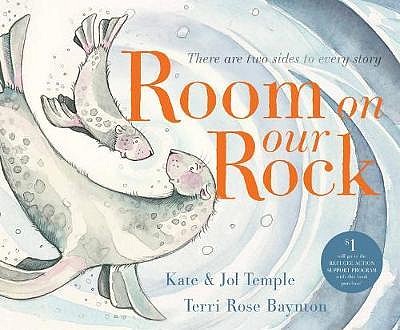
Room on our Rock by Kate and Jol Temple and illustrated by Terri Rose Baynton is a very clever story that you must read twice and it will elicit a different emotional response each time. Read it forwards and then read it backwards to see two different points of view about sharing, welcoming and being inclusive. This is the story about a mother seal and her cub that must leave their home and find a new one. Reading the book from front to back tells a cruel story of rejection, intolerance and refusal to accept the seals. Reading the book from the last page to the first tells a very different story, one of acceptance from compassionate seals. It is astonishing to also see how the illustrations perfectly complement the two very different narratives. This is a powerful and memorable book to share with children to help build capacity for empathy.
Digital Stories about Refugees
Sea Prayer 360 film by Khaled Hosseini (as reviewed in this blog post above) and Adeel Akhtar, Liz Edwards, Francesca Panetta, Nicole Jackson, Shehani Fernando, Mona Mahmood, Anrick Bregman, Andrew Mason, Anetta Jones, Lisa Golden, Peregrine Andrews, So When, Kronos Quartet and UNCHR.
This is a 360 film for Sea Prayer. Click here to play and follow the story as the illustration is drawn. Sourced from The Guardian.

Jilda’s Ark is a fictional story about environmental refugees who have to leave their island home due to sea-level rise. It also focuses on the plight of the animals they have to leave behind.
Hi Verity, thank you so much for taking the time to comment and let me know about your book. I have just looked further into your book and will purchase a copy for my daughter as she is highly interested in learning about climate change from different sources. Your books sounds like a suspenseful read and one that I believe my daughter will enjoy.
I am so appreciative of this blog post thank you so much and for Home’s inclusion.
Hi Karen, thank you so much for your kind words. I thoroughly enjoyed researching this post and reading many books about refugees to create this collection of stories. ‘Home’is such a special book that brings a human dimension to the plight of refugees. I hope many children have the privilege of reading your book.
Thanks so much for your interest in Jilda’s Ark. I hope you and your daughter really enjoy the story.
Thanks so much for your interest in Jilda’s Ark. I hope you and your daughter really enjoy the story.